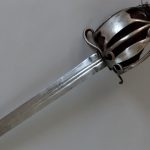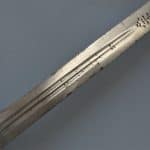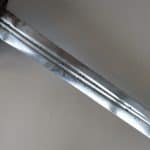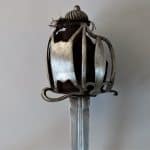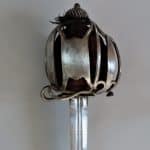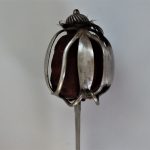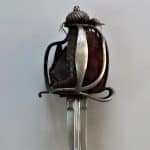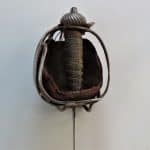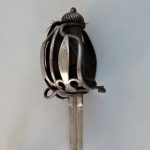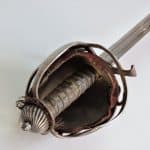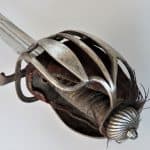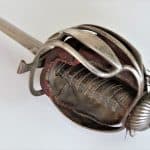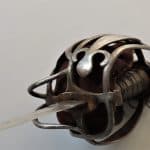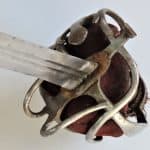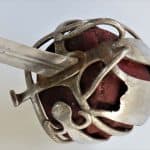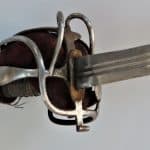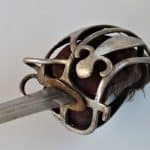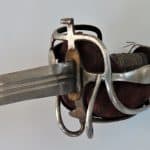
A Rare British Infantry Basket Hilted Sword with ANDRIA FARARA marked blade circa 1735 to 1765
To enquire about this itemplease click here
Price: £3,000
Ref: 070.23
Item Description
A fine British “three-quarter” basket hilted sword made for British infantry soldiers of the line in the mid 18th century. The sword is mounted with a fine quality tapering, double edged, Solingen-made, broad sword blade.
The hilt is formed in the traditional manner for the half of the guard that protects the outside of the hand of a right handed user. In this respect a vertical oblong shaped guard plate is fitted between the flattened knuckle bow and the side guard bar. Then a similar flattened bar with merlons at the base is fitted between the side guard bar and the rear guard bar.
On the other side, the usual side guard bar takes the same form as the knucklebow, and the space between these two flattened bars is occupied by a single, stretched, “S” shaped bar. There is no further protection for the hand on this side of the hilt. Clearly this design of hilt, unique in our experience, assumes that the inside hand of the user can be more economically protected with fewer bars than on the outside which is a deviation from the more usual basket hilt forms of the time. The downward curled wrist guard which extends from the cross guard at the rear and the forward loop guards which appear on more usual basket hilt designs are present.
The pommel is of bun shaped type typical of British military swords of the mid 18th century. It has a multi-faceted button of separate manufacture from which fluted ridges radiate towards the mid line of the pommel. This elaborate feature is hand crafted and a quality embellishment in advance of the usual plain surfaces usually encountered with this pommel type.
The original grip is made of hardwood covered with leather. It is spirally grooved bound with twisted brass wire flanked with narrower wire either side. Iron ferrules are applied top and bottom of the grip. The hilt retains its original red woollen fringe and stitched leather liner covered with red velvet on the outside and the remains of its stitched blue silken hem.
The double edged blade tapers to its tip and has a short ricasso. A double fuller extends for 9 inches from the hilt after which an elaborate cruciform shape is incised into the blade on each side. Each fuller is stamped with “ANDRIA FARARA” each side with the words separated and flanked by pairs of “X” marks. The blade is almost certainly of German manufacture from one the the main European blade making centres such as Solingen.
The slimmed down hilt design was a new innovation for the time deemed appropriate for infantry use. This measure is not a cost saving consideration in the manufacturing process, because the sword is a high quality although plain weapon, made up of sturdy, thick, well worked bars to the hilt, and mounted with a fine blade.
The remarkable painting in the Royal Collection attributed to David Morier (1705? to 1770) entitled “An Incident in the Rebellion of 1745”, painted circa 1753, shows British line infantry repulsing a charge by Highlanders. The depiction of the weapons is deemed important by historians, because Morier is thought to have used actual combatants that took part in the battle as models with the weapons used.
Of significance here are the swords carried by the British line infantry soldiers. These are basket hilted swords with typical bun pommels mounted with guards of three quarter size, similar to our sword, although the arrangement of the bars is slightly different. This may be due to artistic convenience / negligence on the part of Morier, or more likely, is indicative of slight variations in the way colonels often commissioned weapons manufacture for their individual regiments.
See: https://www.rct.uk/collection/401243/an-incident-in-the-rebellion-of-1745
Measurements: The blade is 31.75 inches (80.5 cm) long and overall the sword is 38.25 inches long (97 cm). The ricasso is .75 of an inch long (2 cm). The fullers are 9 inches long (23 cm).



